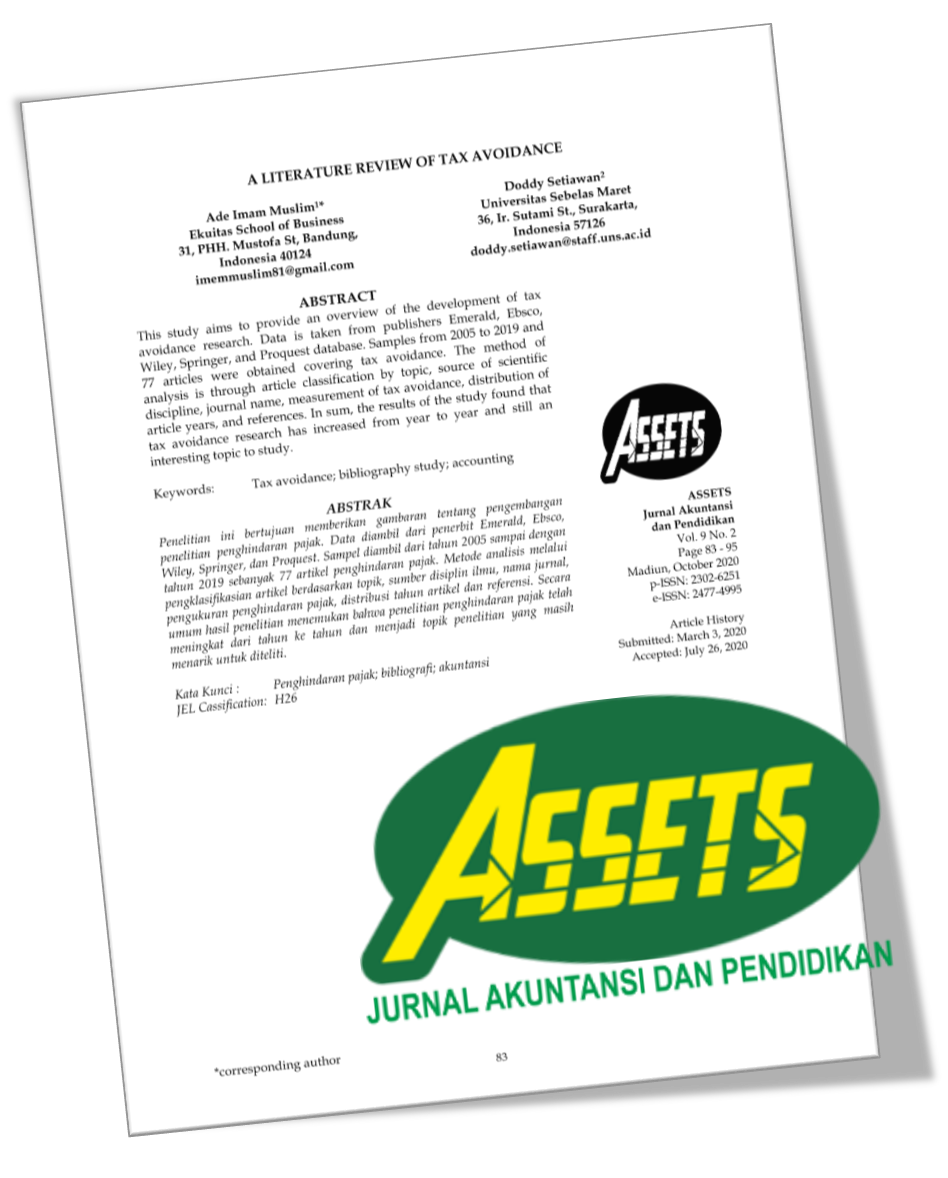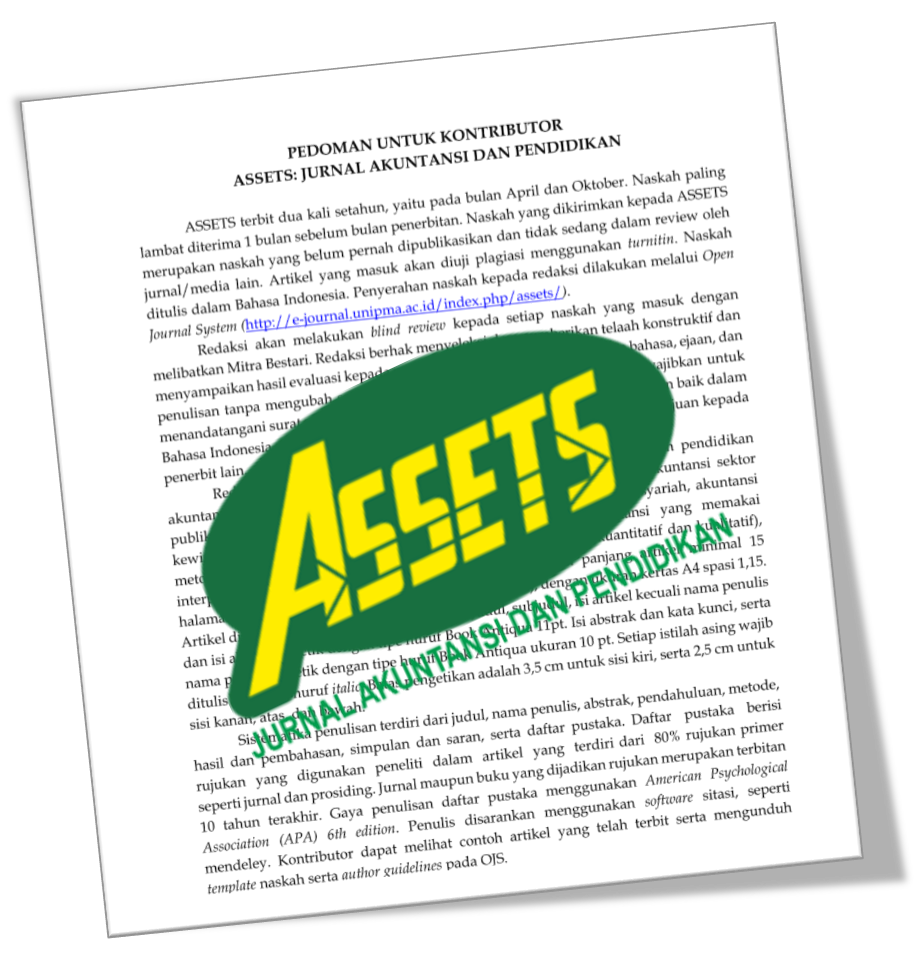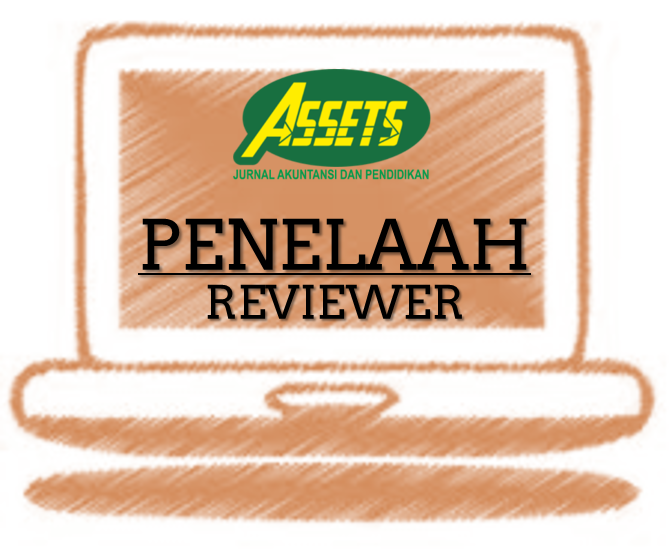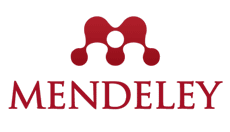Factors Affecting Company's Capability in Performing Integrated Reporting: an Empirical Evidence from Indonesia
DOI:
https://doi.org/10.25273/jap.v7i2.3315Keywords:
integrated reporting, company’s profitability, company size, managerial ownership, institutional ownership,Abstract
This study examines the factors that affect the company's capability to perform integrated reporting. The analysis used in testing the hypothesis is multiple linear regression analysis. Results show that company’s size has positive and significant connection and stakeholder’s pressure has negative and significant connection with the company’s capability in performing integrated reporting. In contrast, level of company’s profitability, company’s managerial ownership, and company’s institutional ownership did not have enough connection with company’s capability in performing integrated reporting.
Â
Downloads
References
Abeysekera, I. (2013). A template for integrated reporting. Journal of Intellectual Capital, 14(2), 227–245. https://doi.org/10.1108/14691931311323869
Ali, W., & Rizwan, M. (2013). Factors Influencing Corporate Social and Environmental Disclosure (CSED) Practices in the Developing Countries: An Institutional Theoretical Perspective. International Journal of Asian Social Science, 3(3), 590–609. Retrieved from https://ideas.repec.org/a/asi/ijoass/2013p590-609.html
Amran, A., & Keat Ooi, S. (2014). Sustainability reporting: meeting stakeholder demands. Strategic Direction, 30(7), 38–41. https://doi.org/10.1108/SD-03-2014-0035
Bidaki, S., & Hejazi, R. (2014). Effects of profitability on the Intellectual Capital Disclosure in listed Companies in Tehran Stock Exchange. Journal of Education and Applied Sciences, 1(5), 248–255.
Chen, Y.-C., Hung, M., & Wang, Y. (2018). The effect of mandatory CSR disclosure on firm profitability and social externalities: Evidence from China. Journal of Accounting and Economics, 65(1), 169–190. https://doi.org/10.1016/J.JACCECO.2017.11.009
David, P., & Kochhar, R. (1996). Barriers to effective corporate governance by institutional investors: Implications for theory and practice. European Management Journal, 14(5), 457–466. https://doi.org/10.1016/0263-2373(96)00039-4
de Villiers, C., Rinaldi, L., & Unerman, J. (2014). Integrated Reporting: Insights, gaps and an agenda for future research. Accounting, Auditing & Accountability Journal, 27(7), 1042–1067. https://doi.org/10.1108/AAAJ-06-2014-1736
Dumay, J., Bernardi, C., Guthrie, J., & Demartini, P. (2016). Integrated reporting: A structured literature review. Accounting Forum, 40(3), 166–185.
Fernandez-Feijoo, B., Romero, S., & Ruiz, S. (2014). Effect of Stakeholders’ Pressure on Transparency of Sustainability Reports within the GRI Framework. Journal of Business Ethics. Springer. https://doi.org/10.2307/42921416
Flower, J. (2015). The International Integrated Reporting Council: A story of failure. Critical Perspectives on Accounting, 27, 1–17. https://doi.org/10.1016/J.CPA.2014.07.002
Frias-Aceituno, J. V., Rodriguez-Ariza, L., & Garcia-Sanchez, I. . (2013). The Role of the Board in the Dissemination of Integrated Corporate Social Reporting. Corporate Social Responsibility and Environmental Management, 20(4), 219–233. https://doi.org/10.1002/csr.1294
Galani, D., Gravas, E., & Stavropoulos, A. (2011). The Relation between Firm Size and Environmental Disclosure. In International Conference on Applied Economics – ICOAE (pp. 179–186).
Huang, C.-J. (2010). Corporate governance, corporate social responsibility and corporate performance. Journal of Management & Organization, 16(05), 641–655. https://doi.org/10.1017/S1833367200001784
Jo, H., & Harjoto, M. A. (2011). Corporate Governance and Firm Value: The Impact of Corporate Social Responsibility. Journal of Business Ethics, 103(3), 351–383. https://doi.org/10.1007/s10551-011-0869-y
Kolk, A. (2008). Sustainability, accountability and corporate governance: exploring multinationals’ reporting practices. Business Strategy and the Environment, 17(1), 1–15. https://doi.org/10.1002/bse.511
KPMG. (2011). KPMG International Survey of Corporate Responsibility Reporting 2011. KPMG International.
McNally, M.-A., Cerbone, D., & Maroun, W. (2017). Exploring the challenges of preparing an integrated report. Meditari Accountancy Research, 25(4), 481–504. https://doi.org/10.1108/MEDAR-10-2016-0085
Rouf, D. M. (2011). The Financial Performance (Profitability) and Corporate Governance Disclosure in the Annual Reports of Listed Companies of Bangladesh. Journal of Economics and Business Research, XVII(2), 103–117. Retrieved from https://papers.ssrn.com/sol3/papers.cfm?abstract_id=2570686
Rusdianto, U. (2013). CSR Communications A Framework for PR Practitioners. Yogyakarta: Graha Ilmu.
Sawarjuwono, T. (2012). Aspek Perilaku Manusia dalam Dunia Akuntansi (Akuntansi Keperilakuan). Surabaya: Airlangga University Press.
Setia, N., Abhayawansa, S., Joshi, M., & Huynh, A. V. (2015). Integrated reporting in South Africa: some initial evidence. Sustainability Accounting, Management and Policy Journal, 6(3), 397–424. https://doi.org/10.1108/SAMPJ-03-2014-0018
Solomon, J., & Maroun, W. (2012). Integrated Reporting: The Influence of King III on Social, Ethical and Environmental Reporting. London: The Association of Chartered Certified Accountants.
Steyn, M. (2014). Organisational benefits and implementation challenges of mandatory integrated reporting. Sustainability Accounting, Management and Policy Journal, 5(4), 476–503. https://doi.org/10.1108/SAMPJ-11-2013-0052
Stubbs, W., & Higgins, C. (2014). Integrated Reporting and internal mechanisms of change. Accounting, Auditing & Accountability Journal, 27(7), 1068–1089. https://doi.org/10.1108/AAAJ-03-2013-1279
Utama, S. (2011). An evaluation of support infrastructures for corporate responsibility reporting in Indonesia. Asian Business & Management, 10(3), 405–424. https://doi.org/10.1057/abm.2011.10
van Beurden, P., & Gössling, T. (2008). The Worth of Values – A Literature Review on the Relation Between Corporate Social and Financial Performance. Journal of Business Ethics, 82(2), 407–424. https://doi.org/10.1007/s10551-008-9894-x
Zadeh, F. O., & Eskandari, A. (2012). Firm Size As Company’s Characteristic and Level of Risk Disclosure: Review on Theories and Literatures. International Journal of Business and Social Science, 3(17).
Downloads
Published
Issue
Section
License
Perjanjian Lisensi dan Hak Cipta
Saat mengirimkan naskah ke jurnal, penulis menyatakan bahwa:
- Mereka diberi wewenang oleh rekan penulisnya untuk masuk ke dalam perjanjian ini.
- Karya yang dimaksud belum pernah diterbitkan secara resmi sebelumnya, kecuali dalam bentuk abstrak atau sebagai bagian dari kuliah, resensi, tesis, atau overlay jurnal yang diterbitkan.
- Karya yang dimaksud tidak sedang dipertimbangkan untuk diterbitkan di tempat lain,
- Publikasi karya yang dimaksud telah disetujui oleh semua penulis dan oleh otoritas yang bertanggung jawab - secara tahu sama tahu atau eksplisit - dari lembaga tempat pekerjaan itu dilakukan.
- Mereka mengamankan hak untuk mereproduksi materi apa pun yang telah diterbitkan atau dilindungi hak cipta di tempat lain.
- Mereka menyetujui lisensi dan perjanjian hak cipta berikut.
Hak Cipta
Penulis yang menerbitkan dengan ASSETS: Jurnal Akuntansi dan Pendidikan menyetujui persyaratan berikut:
- Penulis mempertahankan hak cipta dan memberikan jurnal hak publikasi pertama dengan karya yang secara bersamaan dilisensikan di bawah Lisensi Atribusi Creative Commons (CC BY-SA 4.0) yang memungkinkan orang lain untuk berbagi karya dengan pengakuan kepenulisan karya dan publikasi awal di jurnal ini.
- Penulis dapat masuk ke dalam pengaturan kontrak tambahan yang terpisah untuk distribusi non-eksklusif dari versi jurnal yang diterbitkan dari karya tersebut (misalnya, mempostingnya ke repositori institusional atau menerbitkannya dalam sebuah buku), dengan pengakuan publikasi awalnya di jurnal ini.
- Penulis diizinkan dan didorong untuk memposting karya mereka secara daring (misalnya di repositori institusional atau di situs web mereka) sebelum dan selama proses pengiriman, karena dapat menghasilkan pertukaran yang produktif, serta kutipan lebih awal dan lebih besar dari karya yang diterbitkan.
License and Copyright Agreement
In submitting the manuscript to the journal, the authors certify that:
- Their co-authors authorize them to enter into these arrangements.
- The work described has not been formally published before, except as an abstract or part of a published lecture, review, thesis, or overlay journal.
- That it is not under consideration for publication elsewhere,
- That its publication has been approved by all the author(s) and by the responsible authorities – tacitly or explicitly – of the institutes where the work has been carried out.
- They secure the right to reproduce any material already published or copyrighted elsewhere.
- They agree to the following license and copyright agreement.
Copyright
Authors who publish with ASSETS: Jurnal Akuntansi dan Pendidikan agree to the following terms:
- Authors retain copyright and grant the journal right of first publication with the work simultaneously licensed under a Creative Commons Attribution License (CC BY-SA 4.0) that allows others to share the work with an acknowledgment of the work's authorship and initial publication in this journal.
- Authors can enter into separate, additional contractual arrangements for the non-exclusive distribution of the journal's published version of the work (e.g., post it to an institutional repository or publish it in a book), with an acknowledgment of its initial publication in this journal.
- Authors are permitted and encouraged to post their work online (e.g., in institutional repositories or on their website) before and during submission, as it can lead to productive exchanges and earlier and more extraordinary citations of published work.

ASSETS: Jurnal Akuntansi dan Pendidikan is licensed under a Creative Commons Attribution-ShareAlike 4.0 International License.










